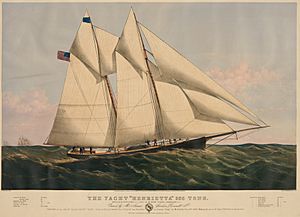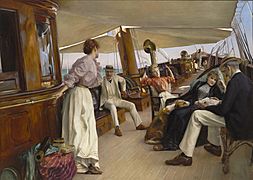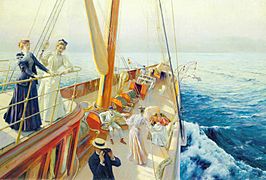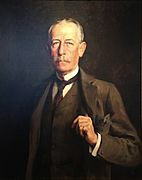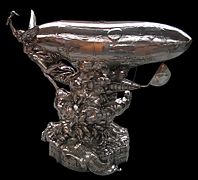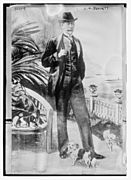James Gordon Bennett Jr. facts for kids
Quick facts for kids
James Gordon Bennett Jr.
|
|
|---|---|
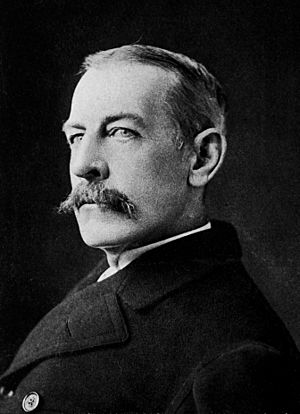 |
|
| Born | May 10, 1841 |
| Died | May 14, 1918 (aged 77) Beaulieu-sur-Mer, Alpes-Maritimes, France
|
| Occupation | Publisher |
| Spouse(s) |
Baroness de Reuter
(m. 1914; |
| Parent(s) | James Gordon Bennett Sr. Henrietta Agnes Crean |
| Relatives | Isaac Bell Jr. (brother-in-law) |
James Gordon Bennett Jr. (born May 10, 1841 – died May 14, 1918) was a famous newspaper publisher. He ran the New York Herald, a newspaper started by his father, James Gordon Bennett Sr.. People often called him Gordon Bennett to tell him apart from his dad.
He loved sports and helped start many new things. He organized the first polo match and the first tennis match in the United States. He even won the first race across the ocean in a yacht! James Gordon Bennett Jr. also helped pay for explorers like Henry Morton Stanley to find David Livingstone in Africa. He also supported the USS Jeannette expedition to the North Pole.
Contents
Early Life
James Gordon Bennett Jr. was born in New York City on May 10, 1841. His father, James Gordon Bennett Sr., was the founder of the New York Herald newspaper. James Jr. was the only son in his family. He spent most of his childhood growing up in France. He also went to a special school there called the École Polytechnique.
Career as a Publisher
In 1861, James Gordon Bennett Jr. moved back to the United States. He joined the Union Navy during the American Civil War. Later, in 1867, he started a new newspaper called The Evening Telegram. This paper focused on entertainment and gossip.
On January 1, 1867, his father gave him control of the New York Herald. James Jr. made the Herald famous around the world. He paid for Henry Morton Stanley's trip to Africa in 1869. Stanley's goal was to find the missing explorer David Livingstone. In return for the money, the Herald got to be the only newspaper to share Stanley's exciting stories.
In 1872, Bennett asked an architect named Arthur D. Gilman to design a building in Manhattan. This building, known as The Bennett Building, still stands today. Later, in 1890, he ordered a new, bigger Herald building to be built. It was finished in 1895.
Bennett also started international versions of his newspaper. In 1880, he launched editions in Paris and London. These papers eventually became the International Herald Tribune, which is now part of the New York Times. In 1883, he helped create the Commercial Cable Company. This company was very successful and brought him a lot of money.
His Exciting Lifestyle
James Gordon Bennett Jr. enjoyed a very fancy lifestyle. Like many wealthy people of his time, he owned yachts and grand homes. He was the youngest person ever to be a Commodore of the New York Yacht Club.
Yachting Adventures
In 1861, Bennett offered his new yacht, the Henrietta, to the U.S. government. It was used by the United States Revenue Cutter Service during the American Civil War. Bennett himself became a third lieutenant in the service. He commanded the Henrietta and helped capture Fernandina, Florida. After his service, the Henrietta returned to being a civilian yacht.
In 1866, Bennett made a bet and won the first race across the Atlantic Ocean. Three American yachts competed: the Vesta, the Fleetwing, and Bennett's Henrietta. Each owner put up $30,000, and the winner took all the money. The race started near Sandy Hook, New Jersey, on December 11, 1866. They raced all the way to The Needles in England. Bennett's Henrietta won in 13 days, 21 hours, and 55 minutes.
He also had a large steam-powered yacht called "Namouna". Artists like Julius LeBlanc Stewart even painted pictures set on this yacht. In 1870, a new pilot boat was named the James Gordon Bennett in his honor.
Moving to Paris and New Ventures
Bennett eventually moved to Paris, France. There, he started the Paris edition of the New York Herald. This paper became the well-known International Herald Tribune. He also helped fund George W. De Long's journey to the North Pole on the USS Jeannette. This expedition faced many challenges, but it made the newspaper even more popular.
He also helped start the Commercial Cable Company. This company aimed to compete with other companies that controlled the underwater telegraph cables across the Atlantic.
Sports and Trophies
Bennett later returned to the United States. He organized the first polo match in the U.S. in New York City. In 1876, he helped create the Westchester Polo Club, which was the first polo club in America.
He loved sports so much that he created several famous trophies. He started the Gordon Bennett Cup for international yachting races. He also created the Gordon Bennett Cup for car races. In 1906, he funded the Gordon Bennett Cup in ballooning, which is still held today. In 1909, Bennett offered a trophy for the fastest airplane speed on a closed track. The American pilot Glenn Curtiss won this race in France. From 1896 to 1914, the best soccer team in Paris received a trophy from Gordon Bennett.
Personal Life
James Gordon Bennett Jr. did not get married until he was 73 years old. His wife was Maud Potter. She was the widow of George de Reuter, whose father, Julius Paul Reuter, founded the Reuters news agency. James Gordon Bennett Jr. passed away on May 14, 1918, in France. He is buried in the Cimetière de Passy in Paris.
Honors
An Asteroid named 305 Gordonia is named after him. There is also a street named for him near Chopin Airport in Warsaw, Poland. The Avenue Gordon Bennett in Paris, where the French Open tennis tournament is held, is named after his father. The ghost town of Bennett, British Columbia, and nearby Bennett Lake and Bennett Peak are named after him.
Gallery
Images for kids
See also
 In Spanish: James Gordon Bennett, Jr. para niños
In Spanish: James Gordon Bennett, Jr. para niños


